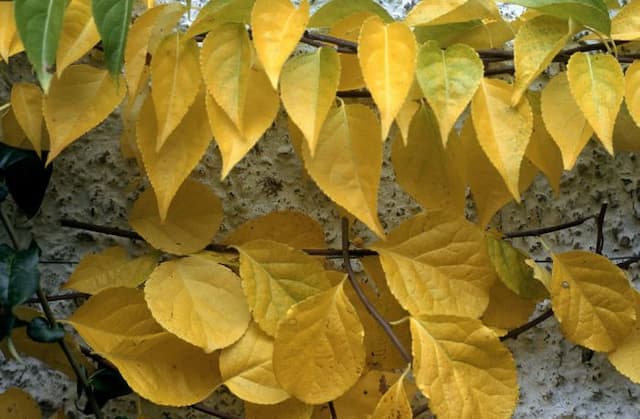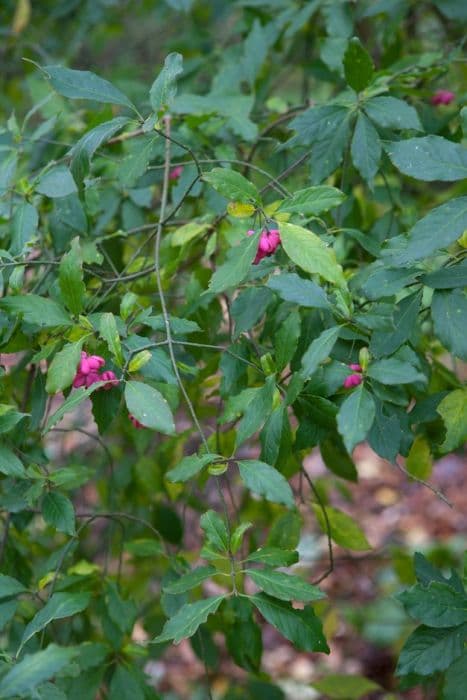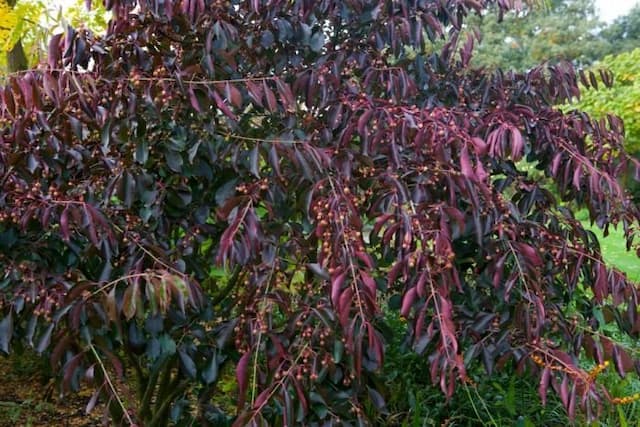Japanese Spindle Bravo Euonymus japonicus 'Bravo' (v)

ABOUT
The Japanese Spindle 'Bravo' is a visually striking shrub known for its variegated foliage. The leaves are a glossy green, adorned with irregular white margins that often appear as though they have been painted onto the leaf surface. The variegation can sometimes be quite pronounced, with the white at the edges being quite broad, while in other cases, it might be more subtle with thinner white edging. Throughout the year, the eye-catching leaves maintain their variegation and provide a durable splash of brightness in garden spaces. While the Japanese Spindle 'Bravo' bears flowers, they are typically small and inconspicuous, often overshadowed by the vibrant leaves. The flowers, when they do appear, are usually greenish-white in color and are not a significant feature of this plant. In terms of growth habit, this shrub often forms a dense, bushy appearance with foliage that covers the plant from the soil line upwards. Branches grow in a somewhat orderly fashion, creating a neat overall aesthetic that can lend itself to formal garden settings or act as lush backdrop for colorful flowering plants. The variegated leaves of the Japanese Spindle 'Bravo' potentially can fade or revert to solid green in the absence of ideal growing conditions, but typically the plant is reliable in maintaining its distinctive patterning. Furthermore, in colder months, the white on the leaves may take on a creamy or pinkish hue, which adds to the plant's seasonal interest.
About this plant
 Names
NamesFamily
Celastraceae.
Synonyms
Japanese Spindle, Evergreen Spindle, Japanese Euonymus, Bravo Spindle.
Common names
Euonymus japonicus 'Bravo'
 Toxicity
ToxicityTo humans
The Japanese Spindle is considered toxic if ingested. This plant contains alkaloids and other compounds that can be harmful to humans. Symptoms of poisoning may include gastrointestinal disturbances such as nausea, vomiting, and diarrhea, as well as more severe symptoms if consumed in large quantities. In some cases, ingesting large amounts could lead to chills, weakness, convulsions, and rapid heart rate. It's essential to seek medical attention if ingestion occurs.
To pets
The Japanese Spindle is also toxic to pets, including both cats and dogs. It contains the same harmful compounds as those that affect humans. When ingested by pets, it can cause symptoms such as vomiting, diarrhea, weakness, changes in heart rate, and in severe cases, seizures. If you suspect your pet has ingested this plant, contact your veterinarian promptly.
 Characteristics
CharacteristicsLife cycle
Perennials
Foliage type
Evergreen
Color of leaves
Variegated
Height
3-6 feet (0.9-1.8 meters)
Spread
2-4 feet (0.6-1.2 meters)
Plant type
Shrub
Hardiness zones
6-9
Native area
Japan
Benefits
 General Benefits
General Benefits- Ornamental Value: Japanese spindle 'Bravo' has attractive variegated foliage, adding aesthetic appeal to gardens and landscapes.
- Low Maintenance: It requires minimal care once established, making it suitable for busy gardeners or those seeking low-maintenance landscaping.
- Drought Tolerance: This plant can tolerate periods of dry weather, which is beneficial in areas prone to drought or for gardeners practicing water conservation.
- Versatile Landscaping: It can be used for a variety of landscaping purposes, including hedges, screens, foundation plantings, or as a specimen plant.
- Tolerance to Varied Conditions: It can thrive in a range of soil types and environmental conditions, increasing its suitability for various locations.
- Evergreen Nature: Being an evergreen shrub, it provides year-round greenery and structural interest in the garden.
- Resistance to Pests: Japanese spindle 'Bravo' is relatively resistant to pests, reducing the need for chemical treatments and maintenance.
 Medical Properties
Medical PropertiesThis plant is not used for medical purposes.
 Air-purifying Qualities
Air-purifying QualitiesThis plant is not specifically known for air purifying qualities.
 Other Uses
Other Uses- Japanese Spindle 'Bravo' foliage can be used as a natural dye, providing a range of greens and yellows depending on the mordant used.
- The wood of Japanese Spindle 'Bravo' is fine-grained and can be used for creating small, intricate woodwork items like inlays and marquetry.
- Japanese Spindle 'Bravo's dense foliage can provide effective sound barriers when planted in thick hedges along roads or between properties.
- The strong branches of the Japanese Spindle 'Bravo' can be harvested and used for crafting durable garden stakes or woven into garden trellises.
- Leaves from the Japanese Spindle 'Bravo' can serve as a natural insect repellent in wardrobes and linen closets when dried and placed in sachets.
- The contrasting variegated leaves of Japanese Spindle 'Bravo' are often used in floral arrangements as a long-lasting, evergreen filler.
- Japanese Spindle 'Bravo' can be sculpted into living sculptures or topiaries for ornate garden displays or competitive exhibitions.
- With proper trimming, the dense growth of Japanese Spindle 'Bravo' can provide privacy screens on balconies and patios in urban environments.
- Japanese Spindle 'Bravo' branches may be used ceremonially in some cultures for decorations during festivals or as part of traditional garlands.
- The plant can serve as an educational tool for botany students to study variegation patterns and hedge maintenance practices in landscape design.
Interesting Facts
 Feng Shui
Feng ShuiThe Japanese Spindle is not used in Feng Shui practice.
 Plant Symbolism
Plant Symbolism- Endurance: The Japanese Spindle 'Bravo' is a hardy plant that can tolerate various conditions, symbolizing the ability to endure and adapt to challenges.
- Protection: Often used in hedges and borders, the Japanese Spindle can represent a barrier against negative forces, symbolizing safety and protection.
- Longevity: With its evergreen nature and long lifespan, the Japanese Spindle is associated with long life and continuity.
- Purity: The bright variegated leaves of 'Bravo' can be symbolic of purity and clarity, contrasting darkness with its light-colored foliage.
- Good Fortune: In some cultures, evergreens like the Japanese Spindle are considered to bring good luck, symbolizing prosperity and good fortune.
 Water
WaterThe Japanese Spindle 'Bravo' should be watered regularly, providing a thorough soaking when the top inch of soil feels dry to the touch. Typically, this may be once or twice a week depending on environmental conditions. During hot, dry periods, more frequent watering may be needed. It is crucial to avoid waterlogging by ensuring good drainage, as the plant does not tolerate standing water. Aim for about 1-2 gallons per watering session, adjusting the amount as needed based on the size of the plant and weather conditions.
 Light
LightThe Japanese Spindle 'Bravo' prefers bright, indirect light or partial shade. Avoid placing it in full, direct sunlight as this may cause leaf scorch. An ideal spot would be where the plant receives filtered light, such as from behind a sheer curtain, or outdoors in a location with dappled sunlight.
 Temperature
TemperatureThe Japanese Spindle 'Bravo' grows best in temperate climates and can handle a temperature range from 30°F to 80°F. The plant can survive occasional dips below freezing but prolonged exposure to temperatures below 30°F may damage the plant. Ideally, maintain temperatures between 50°F and 70°F for optimal growth.
 Pruning
PruningPrune the Japanese Spindle 'Bravo' to maintain shape and remove any dead or damaged branches. It is best to prune in the late winter or early spring before new growth begins. Pruning can be done annually, or as needed to control size and encourage a healthy, denser foliage.
 Cleaning
CleaningAs needed
 Soil
SoilJapanese Spindle 'Bravo' thrives in well-draining, loamy soil amended with organic matter. A mix of two parts garden soil to one part peat or compost and one part perlite or sand is ideal. Maintain a soil pH of 6.0 to 7.5 for optimal growth.
 Repotting
RepottingJapanese Spindle 'Bravo' should be repotted every 2-3 years to prevent it from becoming root-bound. Younger, actively growing plants may require more frequent repotting.
 Humidity & Misting
Humidity & MistingJapanese Spindle 'Bravo' prefers moderate humidity levels but is adaptable to a range of indoor humidity conditions. Aim for a relative humidity around 40-60%.
 Suitable locations
Suitable locationsIndoor
Provide bright indirect light and occasional pruning to maintain shape.
Outdoor
Plant in partial shade, shelter from extreme winds.
Hardiness zone
6-9 USDA
 Life cycle
Life cycleEuonymus japonicus 'Bravo', commonly known as Japanese Spindle 'Bravo', begins its life cycle as a seed, which upon germination in spring, develops into a small seedling with a rudimentary root system and foliage. The seedling stage transitions into the juvenile phase, characterized by rapid growth and the development of a robust root system and evergreen leaves, with variegated cream and green foliage, which is distinctive of the 'Bravo' variety. As it matures, the plant enters the vegetative stage, expanding in height and width, and developing a woody stem structure that can support its dense, bushy form. Upon reaching sexual maturity, which may take several years, Japanese Spindle 'Bravo' produces small, inconspicuous greenish-white flowers in late spring to early summer, though blooming is sparse and may not occur every year. Following pollination, the flowers can develop into pinkish to reddish fruit capsules that open to reveal orange-coated seeds in autumn. The plant continues on in a perennial cycle of growth and dormancy, with older specimens exhibiting a slow growth rate while maintaining dense foliage year-round.
 Propogation
PropogationPropogation time
Spring-Early Summer
Propogation: Euonymus japonicus 'Bravo', commonly known as Japanese Spindle, is usually propagated through semi-hardwood cuttings. The best time to take these cuttings is during the summer when the plant's growth has begun to slow and the stems are not too tender or too woody. Cut a section of stem about 4 to 6 inches (approximately 10 to 15 cm) in length, making sure it includes at least two sets of leaves. The cut should be made just below a leaf node, and the lower leaves should be removed. Dip the cut end in a rooting hormone to encourage root development. Plant the cutting in a pot filled with a mixture of peat and perlite or sand to ensure good drainage. Keep the soil consistently moist and the cuttings in a warm place with indirect light until roots develop, usually within 4 to 8 weeks. Once the cuttings have rooted, they can be transplanted into individual pots.







